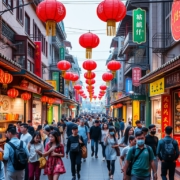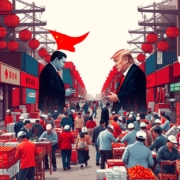Navigating Turbulent Waters: China’s Labor Market Challenges and Economic Future
China Labor Market Struggles Deepen, Clouding Economic Outlook
By Bob Mason, Published September 23, 2025, 03:58 GMT
China’s labor market shows clear struggles. Beijing set a 5% GDP goal this year, but weak export demand, low prices, and rising unemployment pull the economy down. The close links among these issues make it hard for China to switch to a consumption-led model.
Rising Unemployment and Weak Demand
The latest data for August show China’s unemployment rate at 5.3%, just above July’s 5.2%. Youth unemployment now sits at 18.9%, the highest since December 2023. This high rate adds stress for new graduates and young workers who face a tight job market.
Exports from China drop as trade tensions make deals hard. Price wars in the domestic market squeeze profit margins, and companies must cut jobs to save money. Fewer jobs mean consumers spend less. Retail sales in August grew by 3.4% year-on-year, down from 3.7% in July and 4.8% in June. Smaller growth shows that workers worry about their jobs.
Impact of US Policies on China’s Labor Market
US rules now bar some Chinese workers from the American job market. President Trump raised the H-1B visa fee to $100,000 to limit visitors with skills. This change may cut demand for Chinese talent at a time when over 12 million new graduates look for work.
These shifts have led to a drop in consumer confidence. The confidence index fell to 87.9 at the end of Q1 2025, while the long-term average is 108.95. With more doubt about future jobs, private spending slows, which puts more strain on Beijing’s plans to boost domestic demand.
Challenges for Policy Makers and Market Response
Policymakers now face a loop where weak jobs lead to low spending, which then pressures company profits and lowers jobs even more. The housing market also suffers, and global change adds to worries over steady growth.
The People’s Bank of China (PBoC) kept loan rates at 3% for one-year loans and 3.5% for five-year loans. This move shows a careful balance between pushing for growth and keeping finance stable. Bank leaders seem to wait for US–China trade talks to finish before they change policies further.
After talks between President Xi Jinping and President Trump on September 19, many see a chance for trade ease before the Asia-Pacific Economic Cooperation (APEC) Summit. Trump also stopped $400 million in military aid to Taiwan. Some see this as a sign that trade talks may move ahead.
Market Reactions and Outlook
Financial markets now show mixed signs. The CSI 300 and the Shanghai Composite dropped slightly by 0.01% and 1.67% respectively this month, even though both have risen by more than 13% year-to-date. In contrast, Hong Kong’s Hang Seng Index climbed 4.3% in September.
Market experts warn that without more policy help—especially support for the housing sector and more trade break—stocks in China may drop more. Key problems stay, such as US tariffs, a weak labor market, and low export demand.
The Road Ahead: APEC Summit and Economic Prospects
The APEC Summit in South Korea from October 31 to November 1 becomes more important as both Presidents Xi and Trump plan to attend. Many hope the meeting will help ease trade problems between the US and China. Still, experts think that some tariffs will stay, and the global economy must work with them.
Alicia Garcia Herrero, Chief Economist at Natixis Asia Pacific, notes that China has two sides: progress in IT and semiconductors, and struggles in the large real estate market. She points out that limits on Chinese imports—such as the ban on some Nvidia GPUs—may change supply chains further.
Data from the private sector Purchasing Managers’ Index (PMI) in September, due next week, will help guide views on the economic future. If export and job cuts continue, market hope may fall even more. If prices steady and domestic demand picks up, some worries might fade.
Conclusion
China’s job market gets tougher as US trade issues continue, and the economic outlook grows dimmer. As more people lose jobs and worry about spending, Beijing must find strong actions that work. The coming APEC meeting and talk between the US and China will draw much attention as any progress might help bring back trust and guide China toward its growth targets.
Full money-growing playbook here:
youtube.com/@the_money_grower








